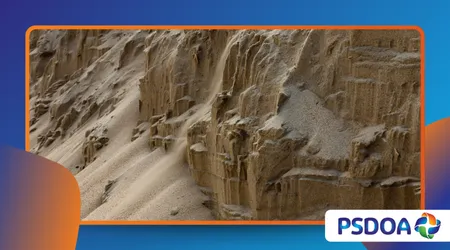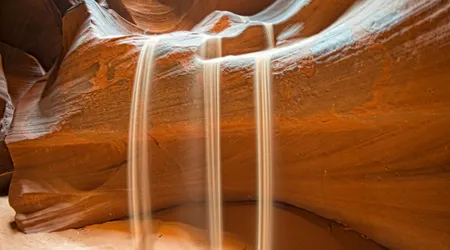Sand Falls: Waterfall-Like Motion of Sand in Deserts and Caves

The vision of water cascading down a cliff face is familiar, yet in some of the world’s most arid or subterranean environments, nature executes this spectacle using a different medium entirely: sand.
Anúncios
This article is your comprehensive guide to Sand Falls, the mesmerizing, gravity-driven movement of granular material that mimics liquid flow in deserts, slot canyons, and deep under the ocean.
These phenomena are prime examples of the intricate physics governing granular media, where sand behaves as a fluid when certain thresholds are met.
The occurrence of Sand Falls challenges our basic perception of landscapes. It forces us to ask: what defines a “waterfall”? Is it the substance or the motion?
The answer lies in the incredible power of gravity and the unique flow dynamics of sand grains. Let’s delve into the mechanics and the most breathtaking locations where these geological miracles occur.
Anúncios
What are the Mechanics Behind Sand Falls in Deserts?
The phenomenon in dry environments, particularly deserts and slot canyons, relies entirely on the angle of repose and the sheer volume of accumulated sand.
How Does the Angle of Repose Trigger Sand Flow?
Every pile of dry, loose material has a maximum slope it can maintain without collapsing this is its angle of repose. For typical dry sand, this angle is around 33 to 35 degrees.
When wind (aeolian process) continually deposits sand atop a dune or cliff edge, the slope eventually exceeds this angle. The slightest disturbance a shift in wind or an underlying structural change can trigger a massive cascade.
This initial slippage causes a domino effect, leading to a sudden, dramatic collapse and flow that perfectly emulates a liquid waterfall. This physics is fundamental to understanding Sand Falls.
++ Fulgurites: Lightning-Formed Glass Hidden Beneath the Ground
Why are Slot Canyons Prime Locations for Desert Sand Falls?
Slot canyons, such as those found in the American Southwest (e.g., Antelope Canyon), are perfect geological traps. Their narrow, vertical walls concentrate wind-blown sand.
Sand accumulates rapidly at the top, and when that material eventually spills over, it is funneled down a narrow channel, enhancing the “ribbon” effect of a waterfall. This is often an internal event, occurring inside the geological formation.
The specific geometry of these canyons tall, sheer walls and narrow passages is crucial for containing and focusing the kinetic energy of the falling grains. This creates spectacular, concentrated columns of cascading sand.

The Unexpected Undersea Sand Falls of the Ocean
Perhaps the most astonishing places to witness this phenomenon are not on land, but miles beneath the ocean’s surface.
How Can Sand Fall in the Water Column?
The most famous examples of Sand Falls occur in deep-sea canyons, where continental shelf sediment is channeled to the ocean floor. The principle is still gravity, but the medium is water.
Also read: Super bloom phenomenon: causes, best locations, and the role of climate
What Role Do Submarine Canyons Play?
Locations like the underwater canyon near Cabo San Lucas, Mexico, feature deep, steep trenches near the coastline. Coastal currents sweep sand into the head of these canyons.
When enough sand accumulates, it becomes unstable and triggers a massive, underwater slump a turbidity current. This dense, sediment-laden flow then cascades down the canyon walls.
The density difference between the sediment slurry and the surrounding seawater allows the sand to fall as a separate, heavy current, appearing as a spectacular underwater waterfall. It’s a complete reversal of our terrestrial expectations.
Read more: Light Pillars: Vertical Beams of Ice and Light in Winter Skies
Is it a True Waterfall or a Turbidity Current?
Geologists classify these events as turbidity currents or submarine landslides, but visually, they are indisputably Sand Falls. They flow like a river of sediment, dropping thousands of feet into the abyssal plain.
This phenomenon is critical for marine geology, as these flows transport vast amounts of sediment, carving out and shaping the deep ocean floor. The volume of material moved is immense.
Analogy: Observing an undersea Sand Falls is like watching milk pour into a glass of water the milk remains distinct for a moment before mixing, illustrating the temporary density segregation of the sand current in the seawater.
Beyond Earth: Sand Falls on the Martian Surface
The physics of granular flow is universal, and evidence suggests that similar cascade events occur on other planets.
Why Does Mars Provide a Planetary Example of Sand Falls?
NASA and ESA rovers have captured images of dark streaks and features on Martian dunes that strongly suggest active, gravity-driven sand flow.
What Evidence Suggests Active Sand Flow on Mars?
Images from the Mars Reconnaissance Orbiter (MRO) show long, dark streaks on the slip faces of dunes, which planetary geologists interpret as Sand Falls. These appear when the dune slope exceeds the Martian angle of repose.
The lower gravity and thin atmosphere on Mars mean the flow dynamics are slightly different, but the core principle granular material cascading down a critically steep slope remains the same.
The scale of some Martian dune flows is monumental, demonstrating that the process of Sand Falls shapes landscapes across the solar system, making this phenomenon truly universal.
Comparing Martian and Terrestrial Sand Movement
While some Martian dune fields move much slower than their Earth counterparts an average of about two feet per Earth year compared to over 100 feet per year for some desert dunes on Eart the rate of sand flux in some regions is surprisingly comparable to Antarctica’s Victoria Valley.
This suggests that despite the atmospheric differences, localized, strong Martian winds are capable of maintaining significant sand activity. The resulting Sand Falls are a dynamic, ongoing process, not merely ancient relics.
Example 1 (Martian Cascade): A recent MRO image captured a dark streak extending down a dune face in the Nili Patera region. This streak, observed in early 2025, is a fresh avalanche track, proving that Sand Falls are a real-time geological process on the Red Planet.
Safety and Environmental Significance
Understanding and observing Sand Falls requires respect for their geological power and environmental context.
How Do These Phenomena Impact Safety and Ecosystems?
Whether in a narrow canyon or a deep ocean trench, these sand movements represent powerful forces of nature that affect the immediate environment.
The Dangers in Slot Canyons
In terrestrial environments, a Sand Falls event in a slot canyon can be dangerous. It signals a major structural instability or a rapid influx of material, potentially preceding a flash flood, the ultimate danger in these arid zones.
Tour guides often demonstrate man-made Sand Falls by pouring a small amount of sand, but a natural, large-scale collapse is unpredictable and forceful.
Ecological Impact of Deep-Sea Turbidity Currents
Underwater, the massive turbidity currents are powerful geological agents, but they can temporarily disrupt deep-sea ecosystems. They are vital, however, for transporting nutrients and organic carbon from the shelf to the deep ocean.
The periodic flushing action of deep-sea Sand Falls helps shape the distribution of benthic (bottom-dwelling) marine life. This showcases the vast, hidden processes that influence oceanography.
Data Citation: According to a study published in the Journal of Sedimentary Research in 2023, deep-sea canyon systems containing Sand Falls or high-frequency turbidity currents account for an estimated 30-40% of all sediment delivery from continents to the deep ocean floor globally.
Key Locations and Types of Sand Falls (2025)
| Location Type | Primary Mechanism | Visual Appearance | Frequency of Occurrence |
| Desert Slot Canyons | Aeolian deposition exceeding the Angle of Repose | Vertical ribbon of sand inside narrow rock channels | Episodic; triggered by wind/instability |
| Ocean Submarine Canyons | Turbidity Current / Sediment Mass Failure | Dense, milky current of sand cascading down the canyon wall | Periodic; triggered by sediment load/earthquakes |
| Large Desert Dunes | Slip Face Avalanching | Broad, sweeping cascade down the steep dune side | Frequent, often during high winds |
| Mars Dune Fields (e.g., Nili Patera) | Gravitational Failure under Low Gravity | Dark, fresh streaks on dune faces observed from orbit | Ongoing; slow but constant process |
Conclusion: A Testament to Nature’s Versatility
The study of Sand Falls from the red-rock deserts of Arizona to the submerged canyons of Cabo and the alien dunes of Mars reveals a core principle: when materials exceed their angle of repose, gravity creates fluid-like beauty.
It’s a powerful reminder that “waterfalls” are defined by dynamic, cascading motion, not just by water. This Sand Falls guide illuminates a geological process that is as spectacular as it is scientifically significant.
This phenomenon is a visual marvel that encourages us to look closer at the physics of the world, whether we are standing on a dune or diving deep beneath the waves.
What other common geological features do you think have a non-water analog waiting to be discovered? Share your thoughts on the surprising fluid nature of sand in the comments!
Frequently Asked Questions (FAQ)
Q: Are the sand falls in Antelope Canyon natural or created by guides?
A: While the underlying mechanism for Sand Falls is natural (sand accumulation and gravity), the smaller, more photogenic cascades often shown in tourist photos are typically initiated by Navajo guides. They gently drop accumulated sand to create the desired visual effect for photographers.
Q: Why is the sand fall phenomenon so much rarer on land than a water waterfall?
A: Terrestrial sand falls require very specific conditions: an extremely steep slope (exceeding the 33° angle of repose) and a constant, dry source of loose, fine-grained material, usually provided by wind. Waterfalls, conversely, only require elevation change and consistent hydrological flow.
Q: Can sand falls generate sound, or are they silent?
A: Sand Falls are usually quite loud in dry, confined spaces like slot canyons. The friction and collision of billions of moving quartz grains generate a distinct, rushing sound, often described as a low roar or hiss. This auditory element adds to the visceral experience of a true Sand Falls.
